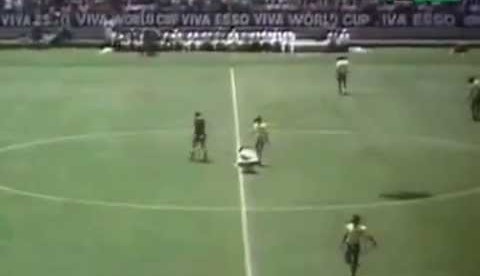Why Pelé Tied His Shoes Before a 1970 World Cup Match

The name Pelé needs no introduction. Edson Arantes do Nascimento — that’s his full, birth name — is widely regarded to be the greatest soccer player of all time. In 92 games for the Brazil national team, he scored 77 goals — that’s as many as the team’s top two active members (Neymar and Ronaldhino) combined. He has three World Cup titles to his credit, too — he was part of the Brazil teams which won the Cup in 1958, 1962, and 1970. He scored a goal in the 18th minute of the 1970 World Cup final, leading Brazil to a 4-1 victory over Italy.
But what he did earlier in the tournament may have had a greater impact than that goal. Here’s a video:
Pelé did not know about the “Pelé Pact,” but things became interesting when Puma sent a representative to the Brazil team named Hans Henningsen. Henningsen was a reporter who had become quite friendly with the Brazilian team. Pelé and Henningsen spent some time together and Pelé was irked that Henningsen, who spent time trying to sign all the other Brazilian team members, never tried to sign him. Finally, Henningsen decided that enough was enough and he made a bold decision. He worked out a deal with Pelé without approval from Puma!
Puma ended up approving the deal and paying Pelé $120,000 — about $735,000 in today’s dollars. But of course, Puma didn’t announce the deal — they didn’t want Adidas to find out — so they had to find a creative way to alert the world about the superstar’s decision to don their sneaks. As part of the deal, Pelé had to ask the referee for time to tie his shoes right before kickoff, in hopes that the cameras would focus on him. (Per some reports, they paid the camera team, too.) It worked, and Puma found fans around the world — and an ongoing enemy in a very upset Adidas.
Bonus Fact: From 1967 until the beginning of 1970, Nigeria was engaged in a bloody civil war that took the lives of as many as 3 million of its citizens. But for two days in 1967, the fighting stopped. The two sides agreed to a 48-hour cease-fire because Pelé was in town to play an exhibition game, and everyone wanted to be free to watch it without having to worry about the war.
From the Archives: The U.S. World Cup Upset No One in America Knew About.
Take the Quiz: Name the winners of the FIFA World Cup.
Related: Pelé’s autobiography, “Why Soccer Matters.” 4.6 stars on 54 reviews.
